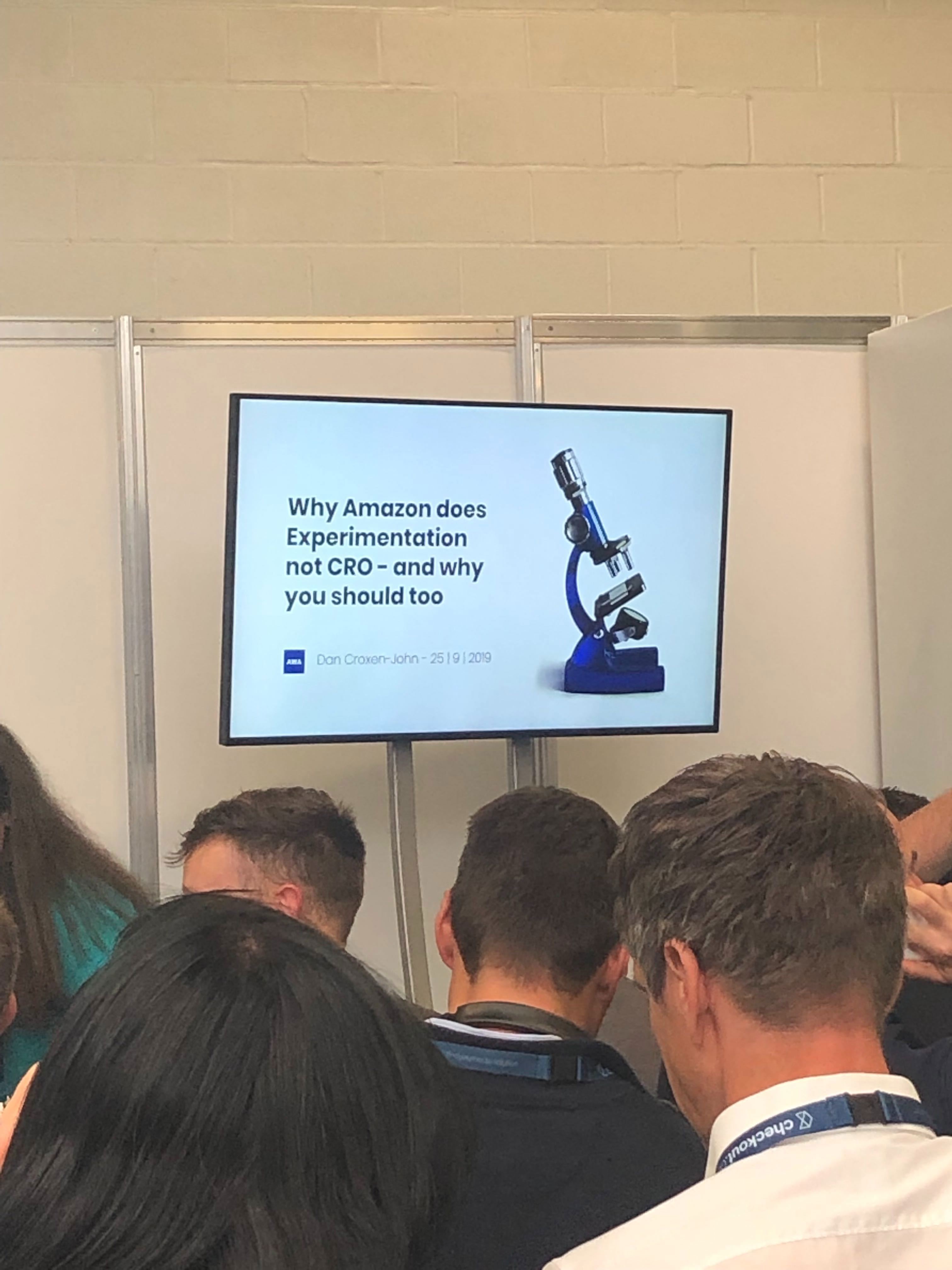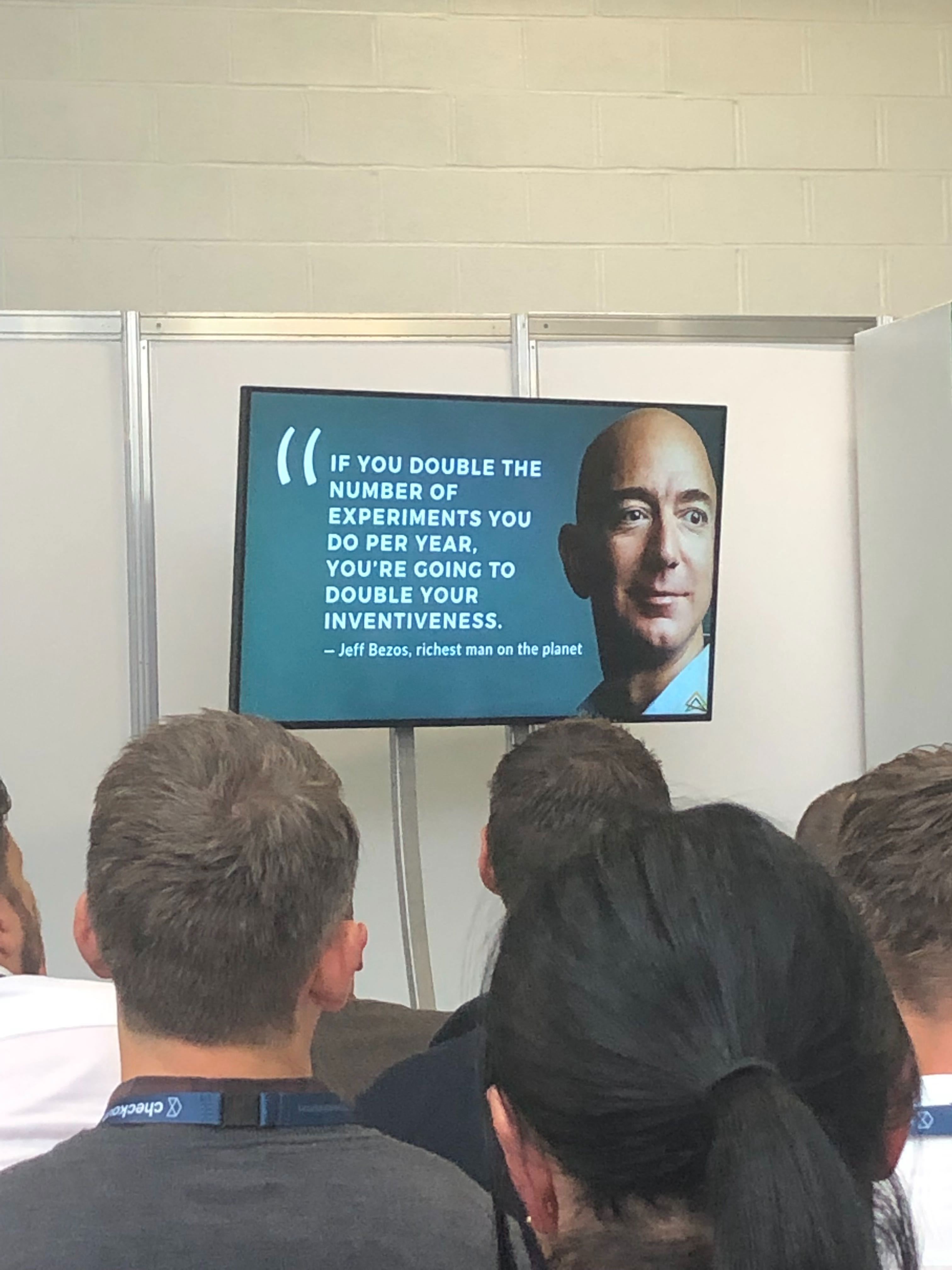We try and get down to Ecommerce Expo every year as its a great FREE event that allows us to keep on top of current trends and best practice. This year was as thought-provoking and interesting as ever!
Customer Journey Hijacking
The hidden problem that’s costing you millions!
This was an interesting talk from a chap called Sam Eisenmann from a company called Namogoo. It seems that as many as 15-25% browser sessions are being hijacked by affiliate marketing malware which serve your competitors ads over the top of your website. Now, being from the digital industry background and having used ad blockers for years this seams hard to believe.
It seems there are a huge number of “infected” browsers out there that have had malware installed either through questionable public WiFi connections or compromised browser plug-ins plus. The most alarming consideration is that people are actively installing the software into their browsers to see “deals” and “offers” without considering how their general website browsing experience might be compromised.
Sam showed lots of examples of where clients had no idea of the size of this problem and what it was costing the bottom line. New Balance shoes appearing in multiple banners over the Nike store to name just one.
Within the presentation, Sam showed a testimonial from one of their clients, Argos who have been working with Namogoo to “block” gorilla 3rd party ads on their site. The Namogoo solutions is a simple 1 line of code inserted through a sites analytics package like Google Tag Manager and looks up any page content that seems questionable against a massive database of question affiliate services and blocks the content from appearing in the users browser. It also uses AI to identify and qualify any suspect page content and shares that information across the clients using their software.
The bottom line is that blocking these gorilla 3rd party browsers ads can improve a sites conversion rate by 1.5-5% which for some of our clients would represent a huge revenue stream. Not to mention not giving valuable business to your competitors.
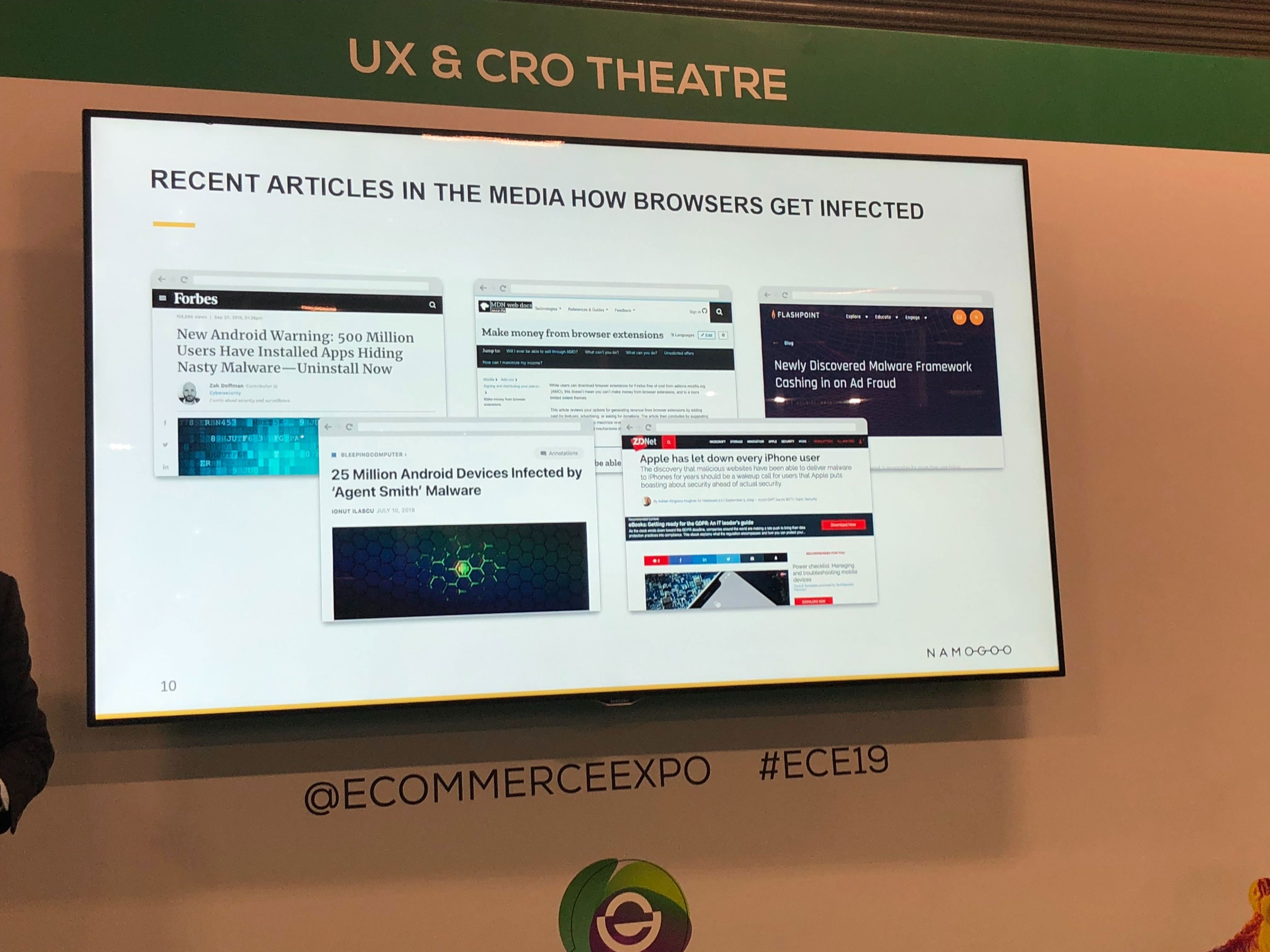
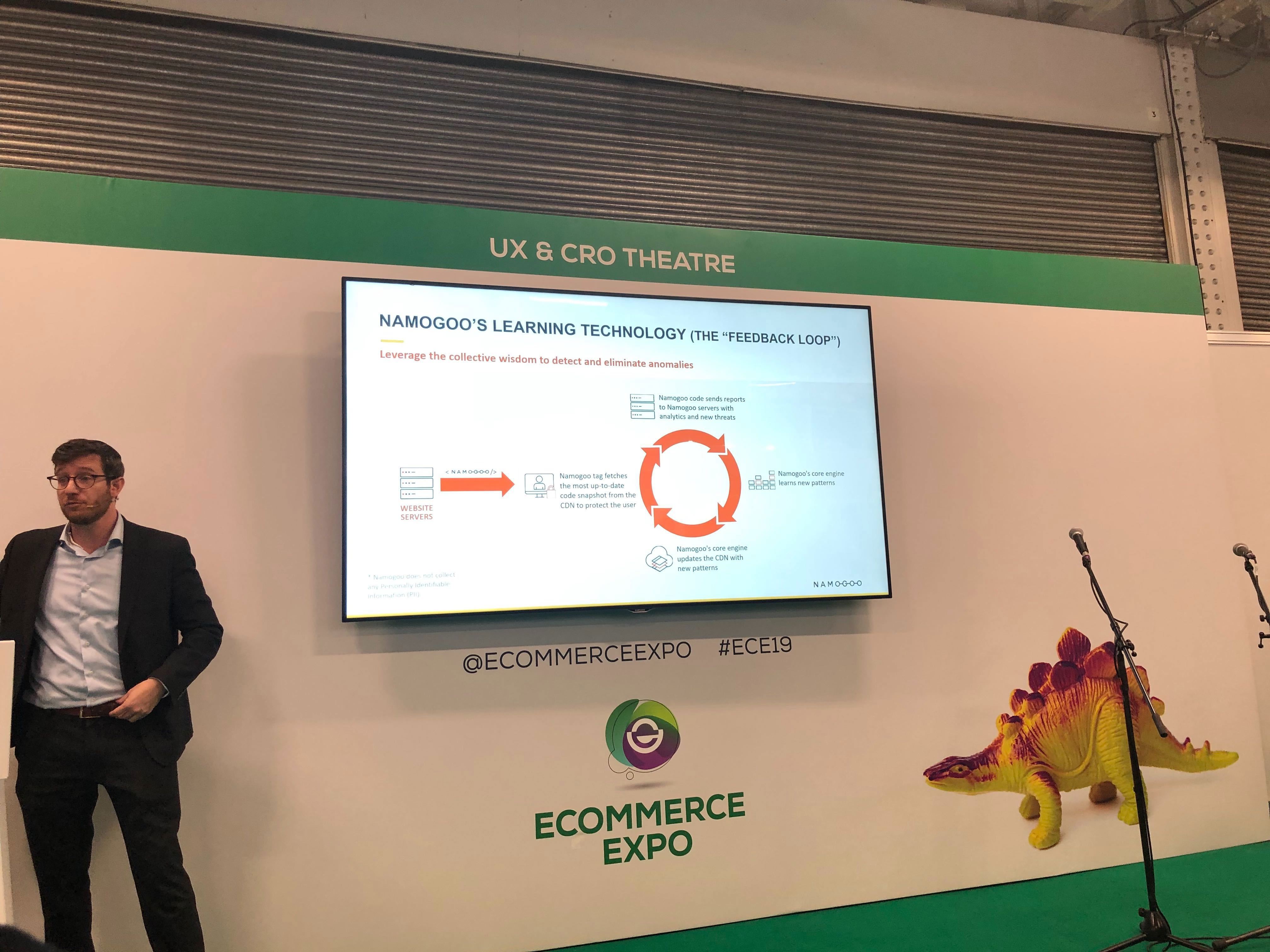
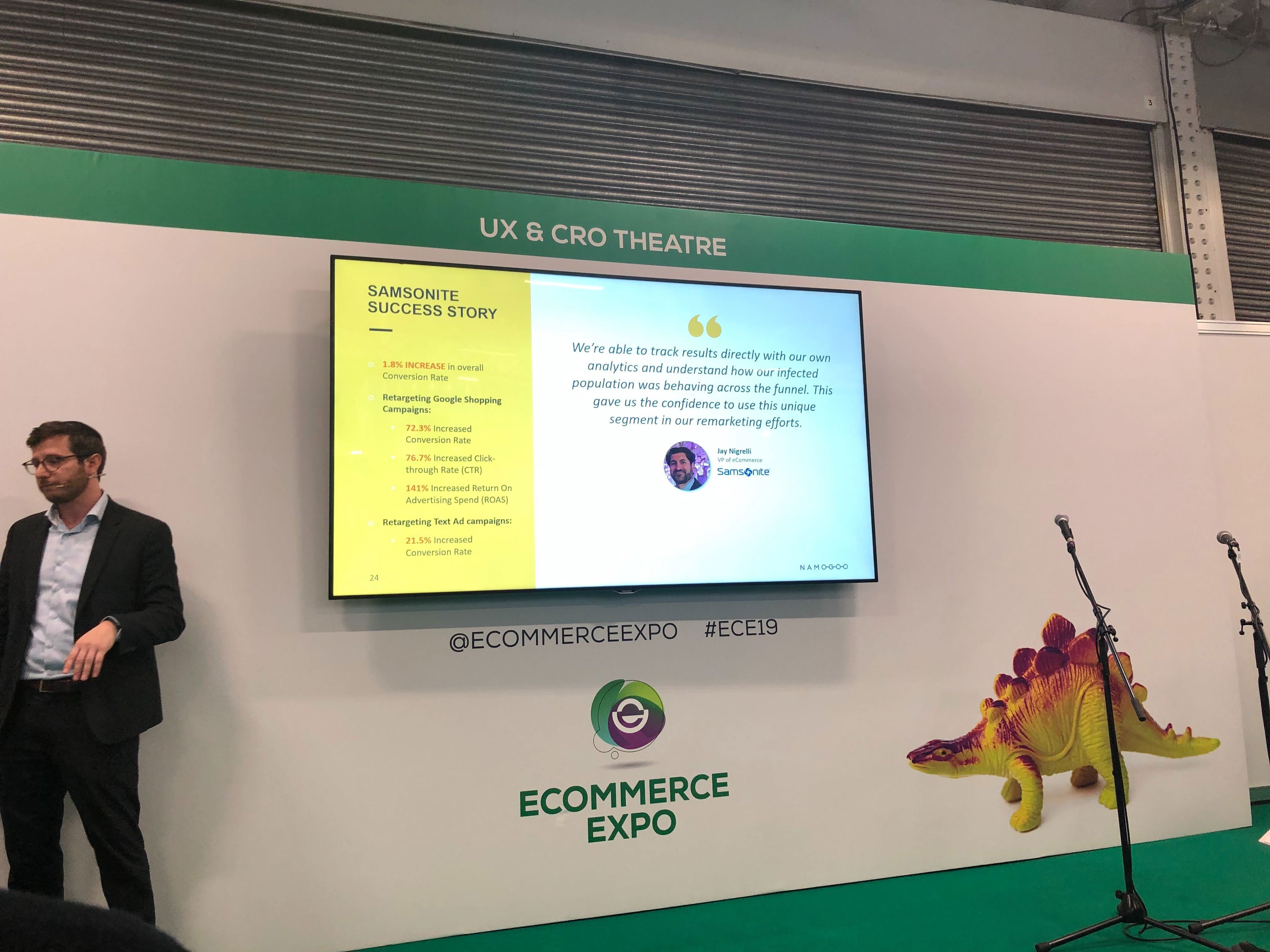
Essential website optimization strategies for 2019
This panel was hosted by Matthew Walsh from IMRG and included Alex Green of 5 Green Stars and Riaz Ali of Giffgaff. The session started with addressing what we should be measuring, the panel was agreeing that Conversion Rate specifically was not the best measure of performance. It's far too general as a measure and may well not truly reflect a fair test. We should be looking at CRO from a very granular level, by acquisition channel, by device, by category, by the time of day or day of the week and even by top-selling products. Even then it's still not going to factor in AOV or revenue which might well be better metrics for a business to make decisions upon. Layered on top of granular conversion tracking was the need to track some of the other important metrics that help lead to conversion, sub-metrics like landing page performance, product views, click-throughs, add-to-baskets and video plays might all help give a better picture of performance.
Alex had some interesting opinions on the role of CRO in the decision-making process, given that there are so many metrics and the potential for flaws in the metrics and measuring practise, he was suggesting that if there are genuine business reasons for making changes, do them anyway. If the changes improve the UI and you know your customers and business inside out it might just be the timing of the CRO test is out and to “trust you gut” rather than press for absolute proof a new variation is better. This was a view backed up by other talks later on!
During the course of discussion Matthew was pressing the panel for practical optimisation ideas and some that were discussed were:
- Content needs to be super short and crystal clear, the team at Giffgaff have identified that around 7 million adults in the UK have a reading age of 9 so tricky words and long copy increase abandonment!
- Product descriptions low converting factor so consider their placement on the product page – this is not news and given the above point makes sense. People buy from images and need key buying info high up on the page – the rest just supports the sale
- Apparently matching ad copy exactly with the landing page copy leads to higher conversion, Giffgaff saw around a 13% uplift by doing this
- Automatically shuffle the category order by landing term the user arrives with. This seems like a no brainer but many sites don’t do this. In Giffgaff’s example if someone’s arriving at a category from google having searched for iPhone, list all the iPhones first then the other smartphone brand below.
- People becoming more cynical about reviews... positive reviewers are more apathetic and given all the paid review services people are putting less weight on them. Instead, Net Promotor Scores (NPS) is increasingly an important metric although there can be friction between improving NPS and Revenue.
- Businesses are forgetting to put “USPs” or key reasons to purchase on their sites as they mature, individuals in the business get bored of them and they get dropped but we still need to remind new users “why buy from us”.
- UGC can be useful in ecommerce purchases where the target market are emotional purchasers and need reassurance from peers. In more generic or price-driven sales this is less relevant.
Why amazon does experimentation rather than CRO
This was probably one of the more interesting talks that I saw at the Expo. Dan Croxen-John gave some really interesting insights about CRO Vs Experimenting.
As per earlier talks there were questions about Conversion Rate and our obsession with it as a metric. Dan pointed out that conversion rate is not a fixed number, it varies and as a result it's fallible. Added to this it doesn’t factor in AOV so revenue at a broader level is not considered. A nice quote was “You can’t bank conversion rate, it’s gotta be revenue”! As such there was a suggestion revenue per visit is a better metric but even then single metrics are no the way to go.
The other key issues Dan takes with CRO is that it lacks ambition and risk-taking. It's fostering a culture of minor tweaks and tinkering in the detail rather than considering the bigger picture and wider more important issues. As a practice, its become more about implementing a checklist of best practice and copying from competitors rather than truly experimenting with new ideas to deliver unique experiences. CRO doesn’t allow for failure, only winners survive despite the fact that today’s loser might be tomorrows winner.
Dan gave some really interesting examples throughout the presentation from Jeff Bezos and his guiding principals that Amazon is founded on experience and they are twinned with failure. He said that if they’d done market research in 2013 asking users if they’d want an always-on cylinder that you can ask questions and play music, the market would have said no and we wouldn’t have had the Echo.
He also gave the example of James Dyson. He’s an inventor and was experimenting for 15 years before the first version the DC01 was launched. This underlines the need for failure, perseverance and also velocity – he created over 5000 iterations and inventions before getting to the DC01.
